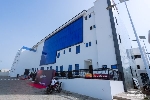Ericsson report charts smarter ports with 5G private networks
 5G-ready private cellular networks provide fast, reliable, and secure connectivity required by a smart port’s network infrastructure to handle the large amounts of data generated by cranes, vehicles, equipment, and workers.
5G-ready private cellular networks provide fast, reliable, and secure connectivity required by a smart port’s network infrastructure to handle the large amounts of data generated by cranes, vehicles, equipment, and workers.
Ports and shipping are vital for a well-functioning global economy. According to the World Bank, in 2019, trade represented more than 60 percent of the global gross domestic product (GDP). Data from The International Chamber of Shipping reveals that shipping plays by far the largest part in this, facilitating roughly 90 percent of the world’s trading. The ports of the world literally keep its goods flowing.
The comprehensive report, Connected Ports: A guide to making ports smarter with private cellular technology, outlines how challenges of equipment downtime, congested port yards for loading and unloading, worker safety, and environmental impact could be resolved with private cellular networks.
5G-ready private cellular networks provide fast, reliable, and secure connectivity required by a smart port’s network infrastructure to handle the large amounts of data generated by cranes, vehicles, equipment, and workers.
In the maritime report findings, Ericsson collaborated with leading sensor technology provider, ifm electronic, as well as researchers from management consultancy Arthur D. Little, to examine and quantify five use cases with the most beneficial applications for smart port technologies:
Remote-controlled ship-to-shore cranes load and unload container ships, moving containers between the ship and the dock with precision and maneuverability. Automated rubber tired gantry cranes stack containers at terminals, crucial for when high-capacity stacking and good maneuverability are needed. Automated guided vehicles(AGVs) navigate through the port using smart 3D sensors, handling all port materials, reducing energy costs and risk of accidents. Condition monitoring detects faults before they occur, reducing unplanned downtime and maximizing asset productivity. Drones deliver documents from ship to shore, reducing costs and environmental impact of crewed boats while also conducting security surveillance of ports.The report projects that if all of the five use cases are deployed together, complete payback can be achieved in less than two years. By year five, the report projects that the ROI would be 178 percent for our standard baseline port.
One port that is already deploying these types of smart technologies is Italy’s Port of Livorno – for example, by leveraging 5G technologies to enhance the exchange of real-time information among actors in the port’s terminal process. These applications have the potential to reduce CO2 emissions by 8.2 percent for one terminal operation.
Learn more by reading the full report, Connected Ports: A guide to making ports smarter with private cellular technology, and try the Smart Ports Value Calculator to figure out the ROI for ports deploying different use cases.
Source: Classfmonline.com
Trending News

V/R: Bee attack on Anloga EP Basic School leaves 2 dead
03:14
Environmental Protection (Mining in Forest Reserves) Revocation Instrument takes effect after 21 days
17:47
'Government Accountability Series': Attorney General, Justice Minister speaks tomorrow Dec 18
20:02
Asantehene arrives in Accra to present Bawku conflict mediation report to President Mahama
15:52
Coalition of Unpaid Nurses demands immediate payment of arrears, threaten strike
15:11
RNAQ Foundation expands anti-hunger crusade to Techiman
18:15
Energy Minister pays tribute to late Prof. Thomas Mba Akabzaa at final funeral rites
16:42
Show of force misplaced — Minority slams security exercise in Accra
18:48
Police arrest two over viral video of child abuse at Agona Jamasi
15:45
Jospong Group builds landmark Pentecost church for community
13:56




